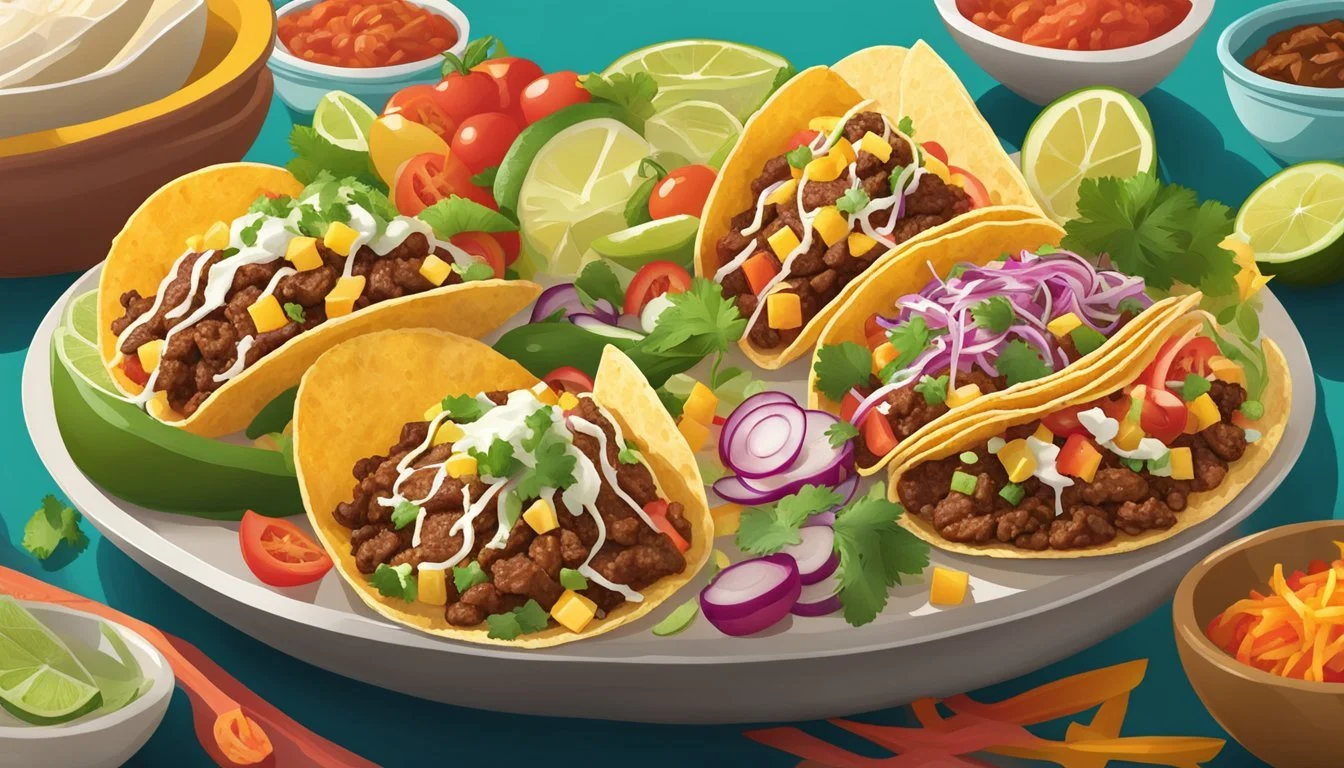How Long Do Beef Taco Bowls Last?
Freshness Guide and Storage Tips
Beef taco bowls are a delightful and easy option for dinner that blends the rich flavors of seasoned beef with fresh accoutrements like avocados, cilantro, and rice. These homemade creations not only satisfy taste buds but are also perfect for meal prep enthusiasts looking to simplify their weeknight dinners.
Properly stored, beef taco bowls can last in the refrigerator for up to 4 days. Ensuring the components are fresh and stored correctly will help maintain their delicious taste and ensure they remain a healthy and convenient meal option throughout the week.
For those looking to prolong their shelf life even further, consider freezing the beef component separately and assembling the bowls as needed. This way, you can enjoy a quick, homemade dinner without any compromise on quality or flavor.
Ingredients and Recipe
Beef taco bowls are a versatile and flavorful meal option, combining seasoned beef with fresh ingredients and various toppings. They are easy to prepare and can be customized to cater to different tastes.
Required Ingredients
For beef taco bowls, require the following ingredients:
Ground beef: 1 pound
Onion: 1 medium, chopped
Taco seasoning: 1 packet
Rice: 2 cups cilantro lime rice
Black beans: 1 can, drained and rinsed
Tomato: 1 large, diced
Lettuce: 1 head, shredded
Cheese: 1 cup shredded
Salsa: 1 cup
Corn: 1 cup
Cilantro: Fresh, chopped
Avocado: 2 large, sliced or diced
Tortilla bowls: Optional
Toppings: Guacamole, sour cream, lime juice
Steps to Prepare Beef Taco Bowls
Cook the Ground Beef:
Heat a large skillet over medium heat.
Add oil and let it heat up.
Sauté the chopped onion for 3-4 minutes until softened.
Add the ground beef and cook until browned.
Stir in the taco seasoning and ½ cup of water.
Simmer until the mixture thickens.
Prepare Additional Ingredients:
Cook the rice as per the cilantro lime rice recipe.
Drain and rinse the black beans.
Dice the tomato and shred the lettuce.
Grate the cheese if not using pre-shredded.
Assemble the Taco Bowls:
Start with a layer of cilantro lime rice.
Add a scoop of seasoned beef.
Top with black beans, diced tomato, shredded lettuce, and corn.
Sprinkle with cheese and add a dollop of salsa.
Include avocado slices and sprinkle chopped cilantro.
Use tortilla bowls for added texture.
Customize and Serve:
Add guacamole, sour cream, and a squeeze of lime juice.
Serve immediately for the best taste.
These steps ensure a delicious and customizable meal suitable for any occasion.
Nutritional Information
Beef taco bowls provide a balanced mix of macronutrients, making them a hearty and satisfying meal. They can be tailored for specific dietary needs based on ingredient choices.
Macronutrients
The macronutrient profile of beef taco bowls typically includes protein, fat, and carbohydrates.
Protein: Lean ground beef is a primary protein source, offering approximately 20-25 grams of protein per 3-ounce serving. This contributes to muscle repair and growth.
Fat: The fat content can vary. Using lean ground beef keeps it around 10-15 grams of fat per serving, with options like Greek yogurt as a topping adding a minimal amount of additional fat.
Carbohydrates: Carbs come from ingredients like rice, beans, and vegetables. A serving could range from 30-40 grams, including dietary fiber which aids digestion.
Dietary Considerations
Ingredients can be adjusted to meet various dietary needs.
Keto/Low-Carb: Substitute rice with cauliflower rice and limit beans to reduce carbohydrate intake.
Dairy-Free: Omit Greek yogurt and use dairy-free alternatives, ensuring the dish remains creamy and flavorful.
Gluten-Free: Ensure tortillas or any grains are certified gluten-free, and check spices for gluten traces.
High-Fiber: Incorporate extra vegetables, beans, and possibly utilize whole grain or high-fiber tortillas.
Low-Sodium: Use homemade taco seasoning to control salt levels, and choose low-sodium broth. This helps manage dietary sodium intake effectively.
Preparation Tips
Proper preparation can make beef taco bowls more flavorful and extend their storage life. Efficient meal prep and ingredient choices are crucial.
Cooking Techniques
To prepare beef taco bowls, start with quality ground beef. Sautéing ground beef in a large skillet over medium heat ensures even cooking. Use oil or cooking spray for the best texture.
For enhanced flavors, add onions and garlic while browning the beef. Seasoning is key—taco seasoning, salt, and pepper should be mixed in as the beef cooks. Use tomato paste and broth for richness.
For those with an instant pot, consider using it for faster and more even cooking. The instant pot can also help blend flavors better. Microwave or stovetop reheating should be done carefully to avoid overcooking.
Ingredient Variations
Traditional ingredients include beef, rice, and beans. For a healthier twist, ground turkey can replace ground beef. It's leaner and lower in calories. Similarly, quinoa or cauliflower rice offers a nutritious alternative to white rice.
Add black beans, corn, and avocados to enhance both flavor and texture. Fresh herbs like cilantro can be used for garnish. A drizzle of Greek yogurt or a sprinkle of cheese completes the dish.
Burrito bowls can be made using similar ingredients but adjusting proportions for a different experience. Tailoring ingredients to taste and nutritional preferences is crucial.
Serving Suggestions
Beef taco bowls are versatile and customizable, making them an ideal dish for a variety of palates. There are numerous toppings and accompaniments that can enhance their flavor and presentation.
Dressing and Toppings
Adding a variety of dressings and toppings can elevate your beef taco bowls. Popular options include salsa, guacamole, pico de gallo, and hot sauce. These condiments provide tangy, spicy, and creamy flavors that complement the seasoned beef.
Fresh cilantro and lime juice offer a bright, fresh finish. Sour cream or Greek yogurt can add a cooling effect to counter spicy elements. Cheddar cheese brings a sharp, savory taste, while black beans add protein and texture. Tortilla chips can be crushed over the top for a delightful crunch.
Accompaniments
Pairing beef taco bowls with side dishes can create a complete meal. Mexican-style rice or cilantro lime rice are popular choices. Beans, such as black or pinto, offer additional protein and fiber. Salads with mixed greens, avocado, and lime wedges provide a refreshing contrast.
For added texture, serve with crispy tortilla chips or soft flour tortillas to scoop up the remaining ingredients. These accompaniments not only enhance the meal but also ensure that it is satisfying and well-rounded.
Common Questions
This section addresses how to make taco bowls healthier and explores alternatives to beef, catering to various dietary preferences and needs.
Making Taco Bowls Healthier
To make taco bowls healthier, low-fat options and adding more veggies are key strategies.
Opt for lean ground beef or switch to ground turkey, which is lower in fat. Adding a variety of vegetables like bell peppers, corn, tomatoes, and lettuce can boost the fiber and nutrient content.
Using whole-grain tortillas adds fiber compared to white flour tortillas. Additionally, reducing the amount of cheese and sour cream can cut down on excess calories and fat.
Consider using Greek yogurt as a healthy substitute for sour cream, which provides similar creaminess with higher protein and lower fat.
Alternatives to Beef in Taco Bowls
For those looking for alternatives to beef, there are several tasty and nutritious options available. Ground turkey is a popular alternative because it's lower in fat but still provides a similar texture and flavor.
For vegetarians, black beans, pinto beans, or lentils can be used to provide protein and fiber. Veggie crumbles made from soy or other plant-based proteins are also excellent options.
Carnitas, made from slow-cooked pork, can be another flavorful substitution, though it's usually higher in fat. For a lighter option, grilled fish or shrimp can be used to create a unique twist on traditional taco bowls while offering valuable omega-3 fatty acids.
With these alternatives, everyone can enjoy a satisfying and nutritious meal.







